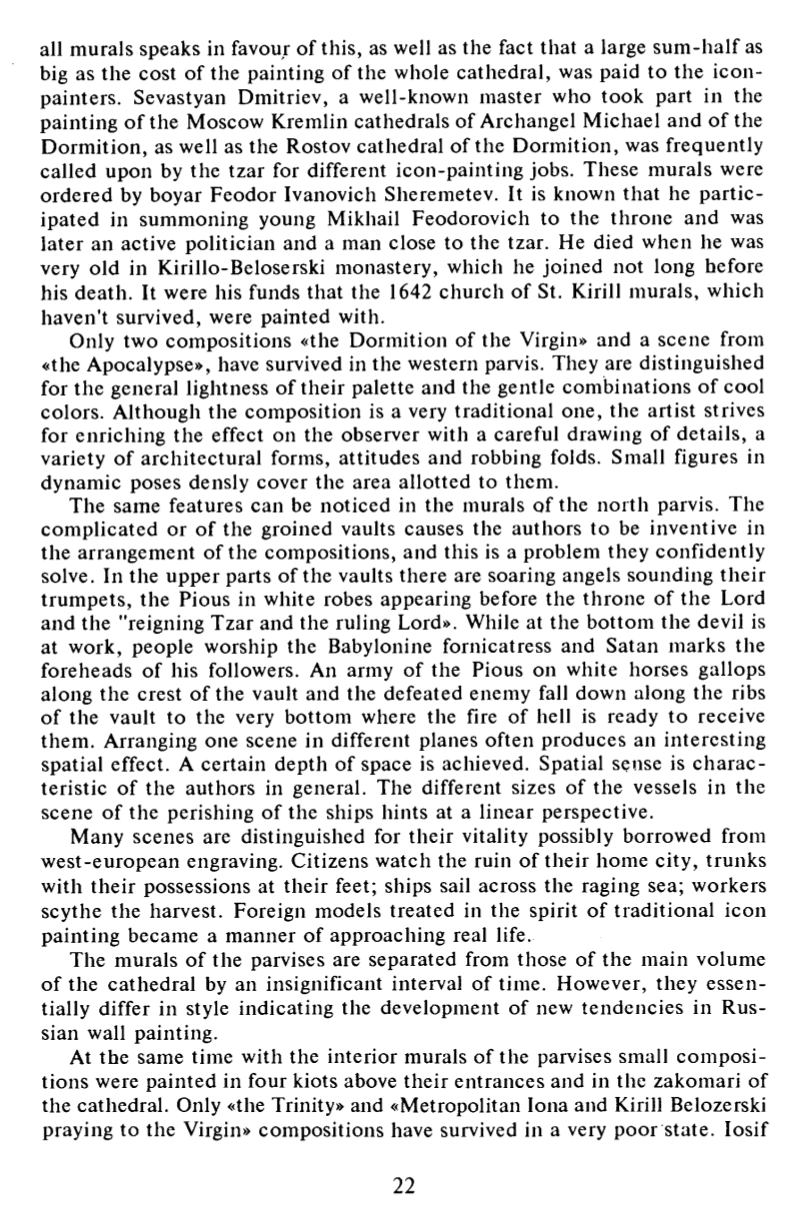

all murals speaks in favour of this, as well as the fact that a large sum -ha lf as
big as the cost of the painting of the whole cathedral, was paid to the icon-
painters. Sevastyan Dmitriev, a well-known master who took part in the
painting o f the Moscow Kremlin cathedrals of Archangel Michael and o f the
Dormition , as well as the Rostov cathedral of the Dormition , was frequently
called upon by the tzar for different icon-painting jobs. These murals were
ordered by boyar Feodor Ivanovich Sheremetev. It is known that he p a rtic
ipated in summoning young Mikhail Feodorovich to the throne and was
later an active politician and a man close to the tzar. He died when he was
very old in Kirillo-Beloserski monastery, which he jo ined not long hefore
his death. It were his funds that the 1642 church of St. Kirill murals, which
haven't survived, were painted with.
Only two compositions «the Dormition of the Virgin» and a scene from
«the Apocalypse», have survived in the western parvis. They are distinguished
for the general lightness o f their palette and the gentle combinations o f cool
colors. Although the composition is a very traditional one, the artist strives
for enriching the effect on the observer with a careful drawing of details, a
variety o f arch itectural forms, attitudes and robbing folds. Small figures in
dynamic poses densly cover the area allotted to them.
The same features can be noticed in the murals o f the no rth parvis. The
comp licated or o f the groined vaults causes the authors to be inventive in
the arrangement of the compositions, and this is a problem they confidently
solve. In the upper parts of the vaults there are soaring angels sounding their
trumpets, the Pious in white robes appearing before the th rone of the Lord
and the "reigning Tzar and the ruling Lord». While at the bottom the devil is
at work, people worship the Babylonine fornicatress and Satan marks the
foreheads of his followers. An army of the Pious on white horses gallops
along the crest o f the vault and the defeated enemy fall down along the ribs
o f the vault to the very bottom where the fire of hell is ready to receive
them. Arranging one scene in different planes often produces an interesting
spatial effect. A certain depth of space is achieved. Spatial sense is c h a r a c
teristic o f the authors in general. The different sizes of the vessels in the
scene o f the perishing o f the ships hints at a linear perspective.
Many scenes are distinguished for their vitality possibly borrowed from
west-european engraving. Citizens watch the ruin of their home city, trunks
with their possessions at their feet; ships sail across the raging sea; workers
scythe the harvest. Foreign models treated in the spirit o f traditional icon
painting became a manner of approaching real life.
The murals o f the parvises are separated from those of the main volume
o f the cathedral by an insignificant interval of time. However, they e ssen
tially differ in style indicating the development of new tendencies in Rus
sian wall painting.
At the same time with the interior murals of the parvises small compo s i
tions were painted in four kiots above their entrances and in the zakomari of
the cathedral. Only «the Trinity» and «Metropolitan Iona and Kirill Belozerski
praying to the Virgin» compositions have survived in a very poor state. Iosif
22















